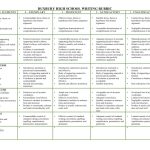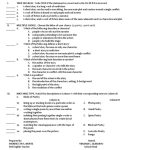Unlock Your Writing Potential: Explore The 8th Grade Creative Writing Rubric Now!
Creative Writing Rubric 8th Grade: A Comprehensive Guide
Greetings, Readers! Today, we will dive into the world of creative writing rubrics specifically tailored for 8th graders. Creative writing is a powerful tool that allows students to express their ideas, feelings, and experiences through storytelling. With the help of rubrics, teachers can provide valuable feedback and assess their students’ writing skills effectively. In this article, we will explore the what, who, when, where, why, and how of creative writing rubric 8th grade, along with its advantages and disadvantages. So, let’s get started!
Table of Contents
Introduction
What is Creative Writing Rubric 8th Grade?
Who Uses Creative Writing Rubric 8th Grade?
When to Implement Creative Writing Rubric 8th Grade?
Where Can Creative Writing Rubric 8th Grade Be Applied?
Why is Creative Writing Rubric 8th Grade Important?
How to Develop Creative Writing Rubric 8th Grade?
Advantages of Creative Writing Rubric 8th Grade
Disadvantages of Creative Writing Rubric 8th Grade
Frequently Asked Questions (FAQ)
Conclusion
Final Remarks
0 Picture Gallery: Unlock Your Writing Potential: Explore The 8th Grade Creative Writing Rubric Now!
1. Introduction
Writing is a fundamental skill that plays a crucial role in a student’s academic journey. It allows them to communicate effectively and express their thoughts. However, assessing and grading creative writing assignments can be subjective and challenging for teachers. This is where the creative writing rubric for 8th grade comes into play. A rubric is a scoring tool that provides clear criteria for evaluating students’ writing based on specific standards and expectations.
By utilizing a rubric, teachers can provide constructive feedback to students, focus on specific areas of improvement, and ensure transparent grading. It also enables students to understand their strengths and weaknesses and work towards enhancing their writing skills. The 8th grade is a crucial stage in a student’s education, as they transition towards high school and face more complex writing tasks. Hence, having a well-defined rubric becomes essential to guide and evaluate their progress effectively.
Image Source: turnitin.com
In the following sections, we will explore various aspects of creative writing rubric 8th grade, starting with its definition and purpose.
2. What is Creative Writing Rubric 8th Grade?
Creative writing rubric 8th grade is a set of guidelines and criteria used by teachers to assess and evaluate the quality of students’ creative writing assignments in the 8th grade. It provides a standardized framework that helps measure the effectiveness of a student’s writing while considering specific elements such as content, organization, language usage, and overall presentation.
The rubric typically consists of different categories or dimensions, each with specific descriptors or levels of achievement. These categories may include creativity, coherence, grammar, vocabulary, and structure. By using a rubric, teachers can provide objective feedback and assign appropriate scores based on predetermined criteria.
It is important to note that creative writing rubric 8th grade may vary across different educational institutions or teachers. However, they often share common elements and principles that focus on encouraging and nurturing students’ writing abilities.
3. Who Uses Creative Writing Rubric 8th Grade?
Creative writing rubric 8th grade is primarily used by teachers, educators, and instructors who teach language arts or English literature to 8th-grade students. It is a valuable tool for both formative and summative assessments, allowing teachers to evaluate students’ progress over time and provide targeted feedback.
Additionally, rubrics can also be beneficial for students themselves. By understanding the expectations and criteria laid out in the rubric, students can self-assess their writing, identify areas of improvement, and set goals for their creative endeavors. This sense of ownership and reflection enhances their overall learning experience and empowers them to take charge of their writing skills.
4. When to Implement Creative Writing Rubric 8th Grade?
Creative writing rubric 8th grade should be implemented whenever students are assigned creative writing tasks in their curriculum. It is crucial to introduce the rubric at the beginning of the academic year or semester to ensure clarity and familiarity with the assessment criteria.
By utilizing the rubric from the start, students become aware of the expectations and standards they need to meet. This allows them to focus on specific areas of improvement and develop their writing skills accordingly. Regular feedback and assessments using the rubric throughout the year help track students’ progress and provide opportunities for targeted interventions.
5. Where Can Creative Writing Rubric 8th Grade Be Applied?
Creative writing rubric 8th grade can be applied in various educational settings, including middle schools, junior high schools, and language arts programs. It is primarily used in English language arts classes, where students engage in creative writing activities such as narrative writing, poetry, or short stories.
Furthermore, creative writing rubric 8th grade can also be utilized in extracurricular writing clubs or workshops to provide a structured and objective evaluation of students’ work. It serves as a valuable tool for teachers and mentors to guide aspiring young writers on their creative journeys.
6. Why is Creative Writing Rubric 8th Grade Important?
The implementation of creative writing rubric 8th grade offers several important benefits for both teachers and students. Let’s explore some of the key reasons why it is important:
6.1 Promotes Clear Expectations
By using a rubric, teachers can establish clear expectations for students regarding the quality and standards of their creative writing assignments. The rubric outlines specific criteria and descriptors, providing a roadmap for success. Students can understand the areas they need to focus on and strive to meet the outlined standards.
6.2 Enables Objective Assessment
A rubric ensures that the assessment process remains fair and consistent. By using predetermined criteria, teachers can evaluate students’ work objectively, minimizing subjective biases. This allows for more reliable and accurate grading, promoting transparency and equity in the evaluation process.
6.3 Provides Feedback for Improvement
The rubric serves as a valuable feedback tool for both teachers and students. Teachers can provide constructive feedback based on the rubric’s criteria, highlighting areas of strength and areas that require improvement. Students can then utilize this feedback to enhance their writing skills and make progress over time.
6.4 Encourages Self-Reflection
By understanding the rubric’s criteria, students can engage in self-assessment and reflection. They can evaluate their own work based on the outlined expectations and identify areas for growth. This self-awareness empowers students to take ownership of their learning and develop their writing skills independently.
7. How to Develop Creative Writing Rubric 8th Grade?
Developing a creative writing rubric for 8th grade involves a thoughtful and systematic approach. Here are the key steps to consider:
7.1 Determine the Focus Areas
Identify the key elements or dimensions you want to assess in students’ creative writing. These may include creativity, organization, language usage, content knowledge, and presentation skills. Tailor the focus areas to align with the specific learning objectives of the 8th-grade curriculum.
7.2 Define Levels of Achievement
Establish different levels or descriptors of achievement for each focus area. For example, you can have levels like excellent, proficient, developing, and emerging. Clearly articulate the characteristics and expectations associated with each level to provide clarity for both students and teachers.
7.3 Assign Weightage or Point Values
Assign appropriate weightage or point values to each focus area based on its importance in the overall assessment. This helps prioritize the different dimensions and ensures a fair representation of the students’ abilities.
7.4 Provide Descriptive Criteria
Within each focus area, provide specific and descriptive criteria that define what each level of achievement looks like. Use clear language and examples to illustrate the expectations of each level. This makes the rubric easier to understand and apply.
7.5 Pilot and Revise the Rubric
Before implementing the rubric, pilot it with a sample of students’ work and gather feedback from both students and colleagues. Revise and refine the rubric based on the insights received to ensure its effectiveness and alignment with the desired outcomes.
7.6 Communicate Expectations
Once the rubric is finalized, communicate the expectations and assessment criteria to the students. Explain the rubric thoroughly, addressing any questions or concerns they may have. This ensures transparency and clarity, fostering a supportive learning environment.
8. Advantages of Creative Writing Rubric 8th Grade
Now, let’s explore the advantages of using a creative writing rubric specifically designed for 8th-grade students:
8.1 Objective Assessment
The rubric provides an objective framework for assessing and evaluating students’ creative writing assignments. It eliminates subjective biases and ensures fairness in the grading process.
8.2 Targeted Feedback
Using a rubric enables teachers to provide specific and targeted feedback to students. It highlights areas of improvement and helps students understand their strengths and weaknesses in writing.
8.3 Consistent Evaluation
With a rubric in place, teachers can evaluate students’ work consistently. This promotes fair grading practices and maintains consistency across different assignments.
8.4 Skill Development
By utilizing a rubric, students can identify their areas of growth and work towards enhancing their writing skills. It encourages self-reflection and empowers students to take ownership of their learning.
8.5 Transparent Expectations
The rubric sets clear expectations for both teachers and students. Students understand what is expected of them, enabling them to align their efforts accordingly and strive for excellence.
9. Disadvantages of Creative Writing Rubric 8th Grade
While creative writing rubric 8th grade offers numerous advantages, it is essential to consider its potential disadvantages as well. Let’s explore them:
9.1 Limitations in Creativity
A rubric may place constraints on students’ creativity by imposing specific criteria and expectations. It may deter students from taking risks or exploring unconventional approaches.
9.2 Overemphasis on Structure
The rubric’s focus on structure and organization may overshadow the importance of unique and authentic storytelling. Students may prioritize following the rubric guidelines rather than exploring their personal writing style.
9.3 Time-Consuming Assessment
Evaluating creative writing assignments using a rubric can be time-consuming for teachers, especially when dealing with a large number of students. The detailed assessment process may limit the time available for other instructional activities.
9.4 Subjective Interpretation
Despite its objective nature, the rubric may still be subject to interpretation by different teachers. There may be variations in scoring and assessment due to differing perspectives or biases.
9.5 Potential for Demotivation
If not implemented effectively, the rubric may demotivate students who do not meet the desired criteria. It is essential to provide support, encouragement, and opportunities for growth alongside the rubric-based assessment.
10. Frequently Asked Questions (FAQ)
10.1 FAQ 1: Can the rubric be adjusted to accommodate individual student needs?
Yes, the rubric can be adjusted to accommodate individual student needs. Teachers can modify the focus areas, descriptors, or weightage based on specific learning goals or individualized education plans.
10.2 FAQ 2: Can the rubric be shared with students before they start their writing assignments?
Yes, it is highly encouraged to share the rubric with students before they start their writing assignments. This provides clarity and allows them to align their efforts with the defined criteria.
10.3 FAQ 3: Can the rubric be used for assessing different types of creative writing assignments?
Yes, the rubric can be adapted to assess different types of creative writing assignments. While the focus areas and descriptors may vary, the underlying principles of evaluating students’ writing skills remain applicable.
10.4 FAQ 4: How often should teachers use the rubric for assessment?
Teachers should aim to use the rubric consistently throughout the academic year. Regular assessments and feedback sessions help monitor students’ progress and provide timely interventions.
10.5 FAQ 5: Can the rubric be used collaboratively for peer assessment?
Yes, creative writing rubric 8th grade can be used for peer assessment as well. Teachers can guide students on how to evaluate their peers’ work using the rubric, fostering a collaborative learning environment.
11. Conclusion
In conclusion, creative writing rubric 8th grade is a valuable tool for evaluating and enhancing students’ writing skills. By providing clear expectations, objective assessment, and targeted feedback, the rubric empowers students to excel in their creative endeavors. However, it is important to strike a balance between structure
This post topic: Creative Writing


